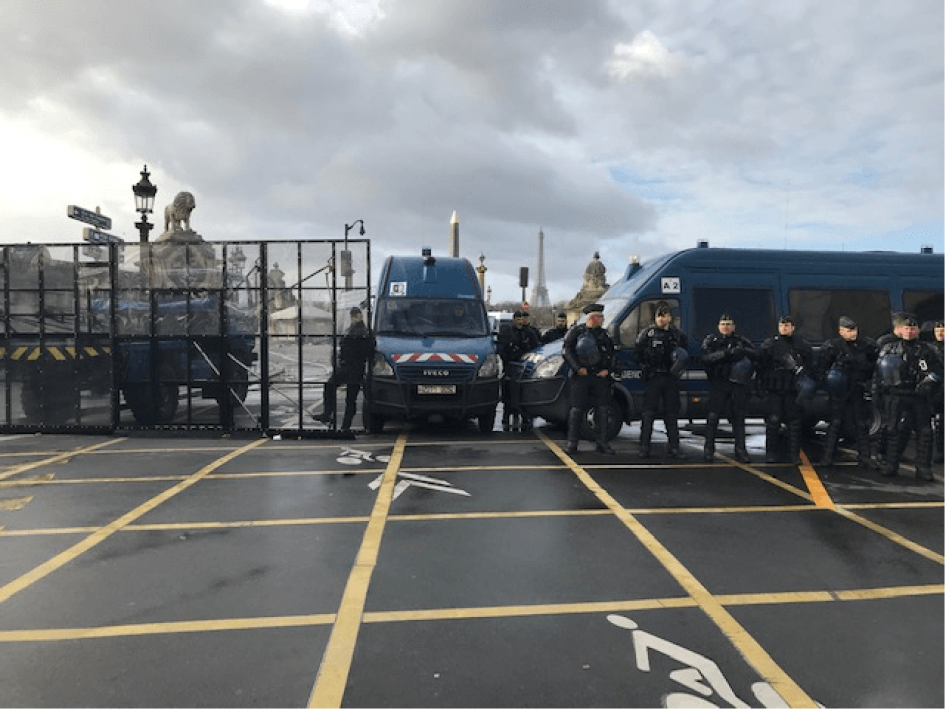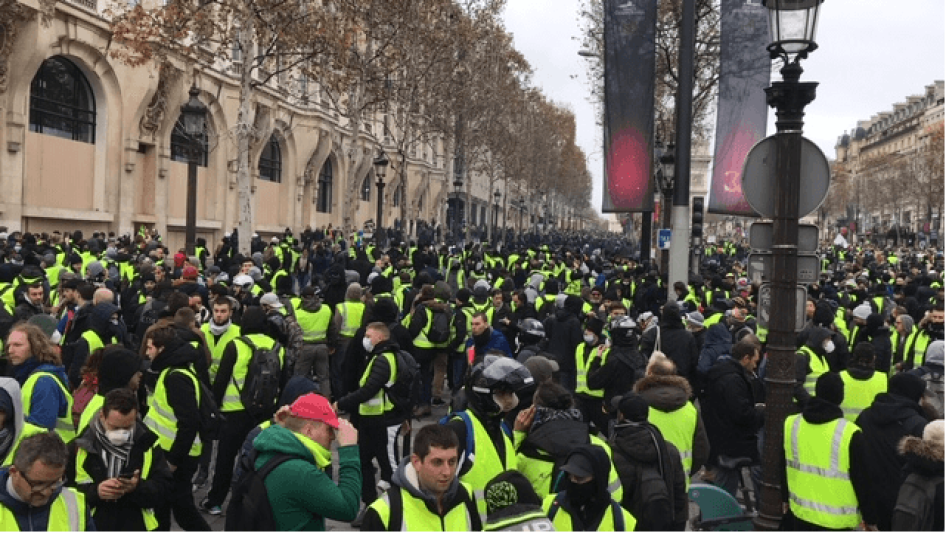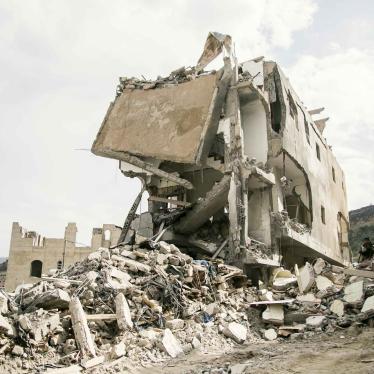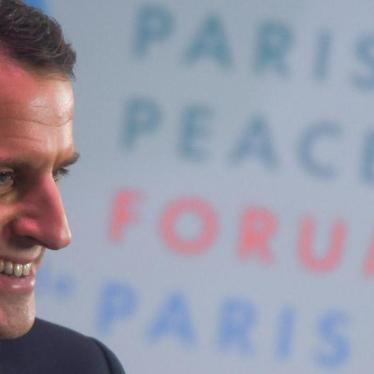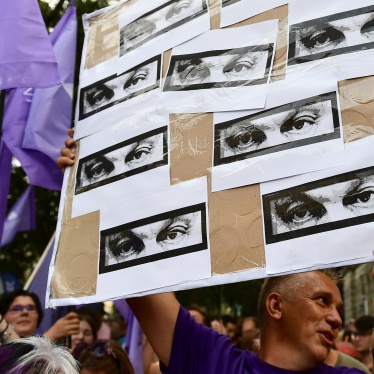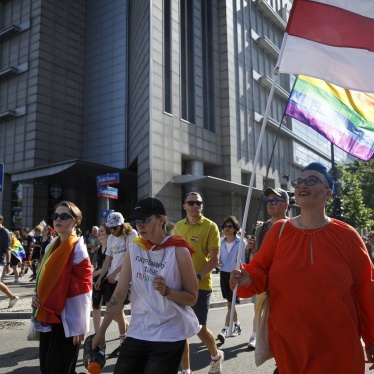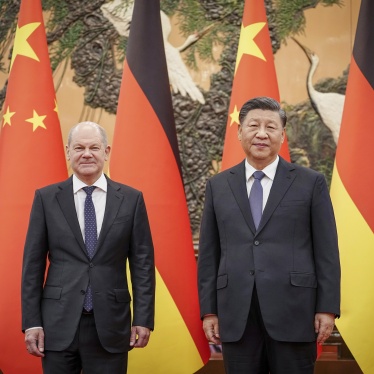(Paris) – French police used crowd control and anti-riot tactics during demonstrations in Paris in November and December 2018 that caused physical harm to peaceful demonstrators, including high-school students, and journalists, Human Rights Watch said today. Law enforcement should exercise greater restraint in demonstrations planned to take place on December 15.
French authorities should investigate whether police tactics were necessary and proportional, and should hold officers to account for excessive use of force. Authorities should immediately ensure that in imminent demonstrations, law enforcement officials exercise the greatest possible restraint and resort to force only when strictly necessary, Human Rights Watch said.
“French police have a tough job policing large crowds of gilets jaunes and protests outside suburban schools, but that doesn’t give them carte blanche to use chemical sprays, tear gas grenades, and rubber projectiles,” said Kartik Raj, Western Europe researcher at Human Rights Watch. “Tactics which may be legitimate for deterring violent demonstrations are not an appropriate response to people gathered peacefully, and can cause horrific injuries.”
Human Rights Watch documented cases of wounds (including head and neck injuries) caused by direct hits with rubber ball-shaped projectiles shot out of a specialized launcher (known colloquially as “flashballs” because of the trademark of one of the manufacturers); burns and physical injury to limbs from the use of supposedly less-than-lethal tear gas grenades which contain a small, secondary explosive charge; and questionable use of tear gas delivered as a spray.
Human Rights Watch observed riot police using “instant” tear gas grenades and so-called “stingball” grenades (riot control grenades that deliver small rubber balls which create a stinging effect, and can carry an additional payload of tear gas) in Paris on December 8, both in situations where they were confronted with violent protesters and when demonstrators were assembled peacefully and offered no imminent threat to the police or the public. Although their use was potentially justifiable when used to disperse protesters engaged in violence and damage to property, Human Rights Watch assessed that at times the police resorted to their use in a disproportionate and unnecessary manner.
Journalists covering the large gilets jaunes, or “yellow vest,” mobilizations, and students (some of whom were children) taking part in unrelated demonstrations outside high schools were among the victims of the police’s heavy-handed tactics.
From the start of December, students around the country have protested at high schools against proposed educational reforms to the baccalauréat, the final high-school exam, and the university system. Most of these demonstrations have been peaceful, but some have involved violence and damage to property. In some cases, students blockaded schools. Riot police deployed to clear high-school blockades have used heavy-handed tactics, including the use of tear gas and rubber projectiles in situations that did not pose a direct threat to police forces.
Since mid-November, hundreds of thousands of protesters, many wearing gilets jaunes, have taken to the streets every Saturday in mass demonstrations, primarily to show their opposition to the government’s tax policy and to highlight socioeconomic inequality. These have included largely peaceful marches in compliance with police directions, acts of civil disobedience, and some acts of violence including arson, looting, damage to property, and attacks on the police. Law enforcement authorities have dealt with these demonstrations with increasing police deployments and escalating riot control measures.
As of December 11, according to official figures, 1,407 demonstrators and bystanders had been wounded, 46 seriously, in the demonstrations. In addition, 717 law enforcement officers and emergency responders have been classed as “victims of violence.” Six people have died in incidents related to the protests, primarily in traffic accidents. The death of an 80-year-old woman in Marseille on December 1, reportedly after exposure to an “instant” tear gas grenade, is under investigation.
The national human rights institution, the Defender of Rights, and a body that previously carried out the Defender of Rights’ police oversight duties, the National Commission for Ethics in Security, have consistently raised serious concerns about the police use of rubber projectile launchers. In 2015, the United Nations Human Rights Committee called on France to train law enforcement officials to stop them from using excessive force or nonlethal weapons in situations that do not warrant them. Since 2002, when the French police started to use rubber projectile launchers, their use has resulted in at least one documented death. Several people have been blinded by rubber projectiles, including a demonstrator hurt on December 8, according to media reports.
On December 6, lawyers acting for demonstrators lodged two formal legal complaints against as yet unknown persons for injuries caused by GLI-F4 “instant” tear gas grenades, which contain 25 grams of high-explosives, used by police in Paris on November 24. In December 2017, the Defender of Rights urged the government to provide improved guidance on the use of nonlethal force, including the GLI-F4 grenade. The lawyers have written to the prime minister calling for an end to this weapon for crowd control.
As of December 11, media reports indicated that the General Inspectorate of the National Police, the internal oversight body, had opened 22 investigations into alleged police misconduct following complaints from 15 gilets jaunes, 6 high-school students, and a journalist.
The UN Basic Principles on the Use of Force and Firearms by Law Enforcement Officials, the European Union Fundamental Rights Agency’s guidance, and the French Police Code of Ethics all stipulate that the use of force, including the use of nonlethal weapons for the purposes of crowd control, is legitimate only when necessary and proportionate.
Authorities should consider stopping the use of tear gas grenades until the guidance around their use has been clarified and direct police to stop using rubber projectiles against peaceful protesters or bystanders or where there is risk of injury to children.
“Heavy-handed policing that harms peaceful protesters isn’t just wrong – it can actually escalate tension and worsen public order,” said Raj. “French authorities should investigate thoroughly all allegations of improper use of force and ‘nonlethal’ weapons, and review police crowd-control guidelines.”
For more detailed accounts, please see below.
Methodology
Human Rights Watch interviewed six people and spoke or corresponded with lawyers for four other people who reported having suffered injury, and interviewed eight eyewitnesses to these injuries. Seven interviewees were children. A Human Rights Watch observer also monitored the policing of demonstrations across Paris (I, II, XIII, IX, and XI arrondissements) on December 8, 2018, some of which were entirely or largely peaceful, and some of which included demonstrators who engaged in violence and caused significant damage to property.
The names of all children, as well as any adults who requested it, have been anonymized to protect their privacy or ongoing legal proceedings. All interviews were conducted in French or English, without interpretation, in person, by telephone, and/or direct message exchanges. Human Rights Watch informed interviewees of the purpose of the interview and its voluntary nature, and they verbally consented to be interviewed.
Journalists injured by police weapons in demonstrations
At least five journalists, two of whom claim they were wearing clear identifying armbands and/or helmets marked “press,” said they were injured by rubber projectiles fired by riot police during gilets jaunes demonstrations on December 8 (most in Paris, one in Tours). They used the trademark name “flashball” to refer to this kind of weapon, regardless of manufacturer.
Journalist unions and press freedom advocates have made public statements about these incidents and brought complaints to police oversight bodies. They also address other policing practices such as bag searches and confiscation of property which they believe infringe their rights to free expression and to seek, receive, and impart information freely. The French government has responded by saying it respects these rights, and called on journalists to always identify themselves clearly.
Boris Kharlamoff, an audio journalist for A2PRL, reported being hit in his torso outside 103 Champs Elysées Avenue on the afternoon of December 8. Kharlamoff wrote to Human Rights Watch:
On this occasion I took the necessary precautions to work safely: helmet, goggles, a mask and a PRESS armband…The tension was such that police in civilian clothing began to use flashballs against demonstrators. In trying to get myself out of this particularly dangerous situation, I was hit in the right side by a flashball. I fell to the floor, as it hurt terribly. Some demonstrators helped me to a place where I could receive care. I then went to see the emergency services to have the wound assessed. The assessment: a big old bruise, but nothing broken. I have to reiterate that when this happened, I had my PRESS armband clearly visible.
Yann Foreix, a reporter for Le Parisien, spoke with Human Rights Watch to confirm details of his account of a rubber projectile injury sustained on December 8 in Paris. In a written account, accompanied by a photograph of damage to his helmet, he said:
I’ve just taken a flashball shot to the neck. I was shot at from behind from about 2 meters away. At close range. I lost consciousness for a few seconds on the floor, and then I was helped back to my feet by several demonstrators, to whom I’m grateful. I thought it was a paving stone. I was evacuated to a hospital. I’ve had a lot of luck. I’ve been released from hospital in a neck brace. The shot didn’t hit any sensitive areas. A few centimeters to either side and I’m not sure it would have ended the same way.
Nigel Dickinson, an independent photographer, gave Human Rights Watch a detailed account of a rubber projectile injury sustained on December 8 in Paris. He says that although he wasn’t wearing a “press” armband, police should have known he was a journalist because he was wearing a helmet and goggles while standing and taking photographs, and police had confiscated such items from people without press credentials at search cordons around the Champs Elysees. He said:
It was a moment of calm. The nearest person was at least 4 or 5 meters away from me. I have no idea why I was hit. There was no tear gas around at the time. It was just a single shot. It was either aimed or mis-aimed at me in the belly, about five centimeters from my belly button. I’ve traveled around the world as a photographer. I’ve had a lot of injuries, car and motorbike accidents. But after this, the first few days I was in shock. I wasn’t adept at doing things, hesitant when crossing the road, going into the metro or even sticking a postage stamp. It was initially a very sharp stinging pain, and then a throbbing pain. It has stopped me from sleeping properly. It’s not as bad as a broken arm, but the pain has stopped me from having a normal life these last few days.
Dangerous use of ‘instant’ nonlethal grenades with explosive charges
One of the complaints lodged collectively before the High Court of Paris (the Tribunal de grande instance de Paris) by lawyers for several individuals injured by tear gas grenades on November 24, states the following:
Mr GX, FX and MX were at the Champs Elysees roundabout at 6 p.m. when they were impacted by an exploding grenade that appears to have all the characteristics of a GLI-F4 grenade.
Throwing this sort of grenade, given that it is known and established to be dangerous, particularly given the nature of the wounds caused to GX, is a positive act of violence. It is irrelevant that GX, FX and MX were not targeted specifically by the person carrying out the violent act, or that he did not intend to cause the harm…because he voluntarily used this type of weapon in a calm area, without following regulations.
Mr GX has a maimed hand and has suffered multiple skin wounds from grenade debris lodging itself particularly in his right leg and face. GX has been operated upon at Hospital X by Doctor X, working under Professor X, with a surgery of the hand and the upper limb and peripheral nerves aimed at reconstructing his hand…
G.X. was still in hospital on December 13. F.X. and M.X. both suffered multiple skin wounds requiring eight and five days of medical leave.
Human Rights Watch also spoke with the lawyer for U.Y., who in separate complaint lodged before the High Court of Paris alongside that of G.X., said that his client suffered a serious foot injury from a nearby tear gas grenade explosion.
Heavy-handed policing of schools
Human Rights Watch spoke with 10 high-school students, ages 15 to 18, who experienced or witnessed what appears to be disproportionate use by French police of nonlethal but injurious crown-control tactics in response to protests by high-school students in early December.
Lycée Simone de Beauvoir, Garges-lès-Gonesse (95th department, Val d’Oise, northern Parisian suburbs, December 4, 2018)
Human Rights Watch spoke with a 17-year-old high school student, I.W., injured by a rubber projectile fired by the police to his lower face during a blockade of his high school on December 5. During the blockade, some trash cans and a tree were set on fire and a mortier (an improvised firework bomb) had been thrown towards the police forces. I.W. was not posing a threat as the unrest had quieted down, according to a fellow student and a teacher who witnessed the scene. Firing a rubber projectile in that situation appears unjustified and not aimed at neutralizing a direct threat to the police forces.
I.W. was hit in the right cheek by a rubber projectile causing an injury that required an operation under full anesthesia and leaving a scar. He has not been back to school since but expects to return on December 17. He told Human Rights Watch:
I arrived at school at 8.30 a.m. to go to class, I didn’t know that school was going to be blocked. The atmosphere was hectic and people from the nearby housing estate were throwing pebbles and firecrackers. I was standing to one side, I did not feel threatened at all because I was there innocently, I did not do anything, so I thought they could not do anything to me. I was just there as a spectator. One person threw stones four meters in front of me, and that’s when the policeman fired the flashball. It was not justified at all anyway. These little stones wouldn’t have hurt the police, they were just pebbles, easy to dodge. They wear a lot of protection and they are trained to handle these things, so they could have solved the problem other than by firing the flashball. I really did not understand their reason for firing it. It’s total injustice, I did not do anything, and I was shot. I had a great feeling of helplessness in front of them. French justice can’t be like that.
A teacher, who witnessed the events, but preferred to remain anonymous because of ongoing legal proceedings, said:
At the beginning a trash can was set on fire, then a tree caught fire. The headmaster called firefighters and the police. While the firefighters dealt with the fire, the police put on their equipment. I heard them say they were equipping themselves to charge or attack…I went to see them to ask them to calm down. They didn’t listen. I returned to the crowd. The police officers began to point their flashballs from a distance... Then some pebbles, not many and small, were thrown. The tension grew. A police officer close to the firefighters began to act in a provoking way. Then from the “radical” side of the demonstration someone threw a homemade firework bomb. It landed quite far from the police, but it set off the intervention. It was done correctly until the police violently restrained and arrested [another student, whom Human Rights Watch also interviewed]. That took about 30 seconds, which were pretty violent, and then he was handcuffed. After that the police returned to their positions. The protesters went back too. Then there was a second exchange, which took place further away, which I did not see, near the bakery. At that time, the central part [outside the school gate] was calm. I.W. was speaking with other students. I was talking to the students. Then a flashball was shot into I.W.'s head. The group he was with wasn’t doing anything other than just being there. The shot was direct.
Lycée Louis Jouvet, Taverny (95), December 4, 2018
In another high school in Taverny, a suburb north of Paris, police forces used tear gas spray in a manner that appears unjustified. High-school students told Human Rights Watch that policemen used tear gas to direct the students into the school building and that students were not complying with the direction but were not being violent. Video footage confirms this account.
R.Q., a 15-year-old student, said:
On Tuesday, I arrived at school at 9 a.m. and went to class. At the 10 a.m. break, I went out in front of the school. Because some students started blocking the school, I wanted to go home. But the police started blocking students with their shields, they did not let people go home. The police wanted to force us back into high school, but they do not have the right to do that. I was in the crowd that the police officers were pushing when they sprayed us with gas. They sprayed us with gas for nothing...I inhaled a fair amount of the gas, it hurt me, it burned. Two girls near me fell, they fainted. Three people went to the hospital.
